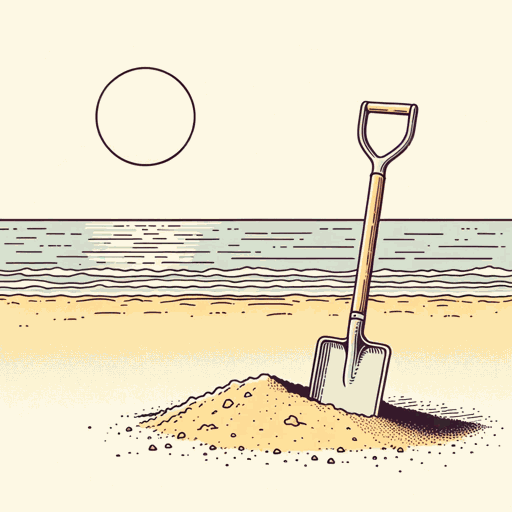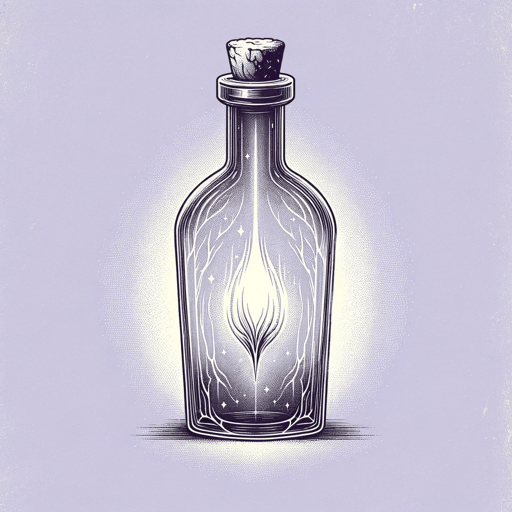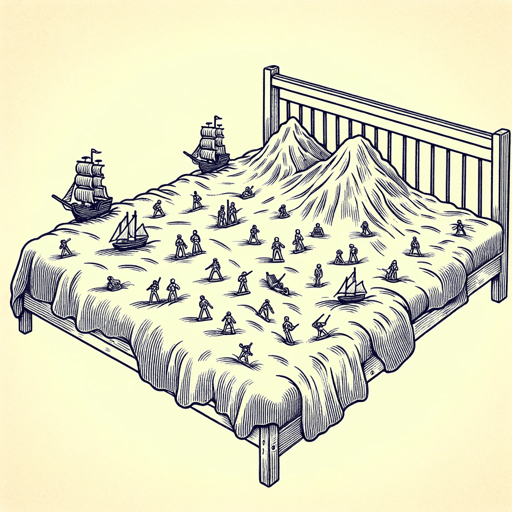19 pages • 38 minutes read
Robert Louis StevensonThe Land of Counterpane
Fiction | Poem | Middle Grade | Published in 1885A modern alternative to SparkNotes and CliffsNotes, SuperSummary offers high-quality Study Guides with detailed chapter summaries and analysis of major themes, characters, and more.
Summary and Study Guide
Overview
Robert Louis Stevenson published “The Land of Counterpane” in 1885 as part of his collection A Child’s Garden of Verses. The collection was dedicated to one of his nurses he had while growing up, Alison Cunningham, whom Stevenson affectionately called “Cummy” and who read to the young Stevenson from various texts. Stevenson wrote during the Victorian Period, when advancements in science and technology were continuously changing and improving and when imperialism and colonialism still were prominent in parts of the word. “The Land of Counterpane” can be considered a lyric poem, as it gives the author’s personal feelings and thoughts. It can also be categorized as a narrative poem, as it tells the story of the speaker’s imagination creating their own world right before their eyes. Stevenson’s biography provides a framework through which to read “The Land of Counterpane”; just as the speaker is ill in the poem and has to entertain themself while they rest in bed, Stevenson was a sickly child and his illness followed him into adulthood. He did a good portion of his writings during convalescence. His descriptions of illness and coping with sickness came from firsthand experience. The text speaks to the power of the imagination and the creative individual to surpass the physical limits of the body and maintain a sense of identity, advocating for positive responses to seemingly negative situations.
Poet Biography
On November 13, 1850, Robert Louis Stevenson was born in Edinburgh, Scotland. His father, Thomas, carried on the family tradition of being a lighthouse engineer. In fact, Stevenson’s family built the majority of the “deep-sea lighthouses” along Scotland’s coast. Stevenson’s mother’s name was Margaret Isabella Balfour. The Balfours’ primary occupations consisted of lawyers and clergyman. As a child, Stevenson was often ill. Instead of going to school, he was frequently kept home to convalesce. A parade of private tutors and nannies provided Stevenson with the majority of his education, and it was through his “somewhat isolated childhood” that “a healthy imagination through which dreams of being a writer developed” (“Robert Louis Stevenson: The Life.” Robert Louis Stevenson Museum).
Since his father’s family members were engineers, the family assumed that Stevenson would enter the same occupation. At the age of 17, Stevenson began his studies at Edinburgh University to pursue a degree in engineering. However, Stevenson had no passion for engineering and, to appease his father, began studying law instead. In 1875, he completed his law school education but never practiced or pursued this career further. Throughout his time at university, Stevenson began cultivating his love of art and writing. He also formed a new, liberal identity directly opposed to the bourgeoisie. Stevenson visited France and mingled with other writers and artists, grew his hair long, wore a velvet jacket, developed atheist views, and joined fellow writers in the university’s Speculative Society.
In 1876, Stevenson visited the French village of Grez and met Fanny Osbourne. Osbourne, an American from California, was in France with her two children, Belle and Lloyd. Osbourne was separated from her husband at the time, and she and Stevenson soon formed an attachment. Osbourne then returned to California, and Stevenson meet her in America in August of 1879. After a series of adventurous travel experiences, Stevenson and Fanny married in 1880 following her divorce with her first husband. The family then moved to Scotland.
It was during this period of his life when some of Stevenson’s first publications began to appear. The first book Stevenson published, An Inland Voyager, appeared in print in 1878. It details Stevenson’s trip from Antwerp to northern France via canoe. The following year, Stevenson published another piece of travel writing, Travels with a Donkey in the Cevennes. The Amateur Emigrant, fully published in 1895, details Stevenson’s journey to California to meet Fanny. Following his travel writing, Stevenson turned his attention to the short story form. In fact, it is said that Stevenson “initiated the British tradition” of short story writing/publication. His first short story was “A Lodging for the Night,” published in 1877. This was followed by a collection of short stories titled New Arabian Nights (1882). Other famous short stories Stevenson produced include “Thrawn Janet” (1881), “Markheim” (1885), and “Olalla” (1885). These short stories were published as a collection titled The Merry Men and Other Tales and Fables (1887).
The bouts of illness which Stevenson suffered as a child did not fade as he got older. During the 1880s, Steven again experienced trouble with his lungs (possibly caused by tuberculosis) that again relegated him to his home and his bed. Confined to bed, Stevenson produced longer works of fiction. His first children’s book, Treasure Island, appeared in book form in 1883. Prince Otto appeared in 1885, Kidnapped followed in 1886, The Strange Case of Dr. Jekyll and Mr. Hyde in 1886, The Black Arrow in 1888, and The Master of Ballantrae in 1889.
It was his repeating sickness which also spurred Stevenson’s travels. He and his family spent some time in Switzerland under the advice of Stevenson’s physician. Between 1881 and 1882, Stevenson would alternate between spending time in Switzerland and Scotland. In September of 1882, lung hemorrhages forced the family to travel to the coast of France. A cholera outbreak sent the Stevensons back to England, where his health became worse due to the climate.
Stevenson traveled with family to the United States in August of 1887, and in June of 1888 they sailed from San Francisco around the Pacific. Stevenson and his family would stop at various Pacific islands, including the Hawaiian islands, to explore and live before picking up and moving on to the next island. The family settled in the Samoan islands in 1889, building Vailima, their home. These Pacific travels inspired Stevenson’s writing. The Wrecker (1892), Island Nights’ Entertainments (1893), The Ebb-Tide (1894), and In the South Seas (1896) all contain tropical island settings and themes. Many people consider Stevenson’s later works more polished and mature than earlier works. In the end, it was not the tuberculosis which killed Stevenson. Rather, on December 3, 1894, Stevenson had a brain hemorrhage that resulted in his death.
Poem Text
When I was sick and lay a-bed,
I had two pillows at my head,
And all my toys beside me lay
To keep me happy all the day.
And sometimes for an hour or so
I watched my leaden soldiers go,
With different uniforms and drills,
Among the bed-clothes, through the hills;
And sometimes sent my ships in fleets
All up and down among the sheets;
Or brought my trees and houses out,
And planted cities all about.
I was the giant great and still
That sits upon the pillow-hill,
And sees before him, dale and plain,
The pleasant land of counterpane.
Stevenson, Robert Louis. “The Land of Counterpane.” 1885. poets.org.
Summary
Stevenson’s poem opens with the speaker setting the scene for readers. They are sick and confined to their bed, stuck in their bedroom. While this may seem initially like a negative situation, the speaker is quite content and happy to play with their toys. To pass the time, the speaker imagines that their soldiers have come alive and are performing drills among the sheets, which the speaker sees as “hills” (Line 8). In addition to their soldiers, the speaker likewise casts their net of creativity over their toy ships and “sees” (Line 15) them sailing around their counterpane, or bedspread. The speaker imagines cities and societies popping up before their eyes, complete with trees and houses. At the end of the poem, the speaker reflects on how content and relaxing it is to look at their creations. Like a giant surveying the landscape before them, the speaker is completely and pleasantly captivated with the world they have built. Also like a giant, they have authority over what lies before them, a sense of self that is larger than life despite their sickness.
Related Titles
By Robert Louis Stevenson

At the Sea-Side
Robert Louis Stevenson

Kidnapped
Robert Louis Stevenson

Markheim
Robert Louis Stevenson

Requiem
Robert Louis Stevenson

The Black Arrow
Robert Louis Stevenson

The Bottle Imp
Robert Louis Stevenson

The Master of Ballantrae
Robert Louis Stevenson

The Strange Case of Dr. Jekyll and Mr. Hyde
Robert Louis Stevenson

Treasure Island
Robert Louis Stevenson

